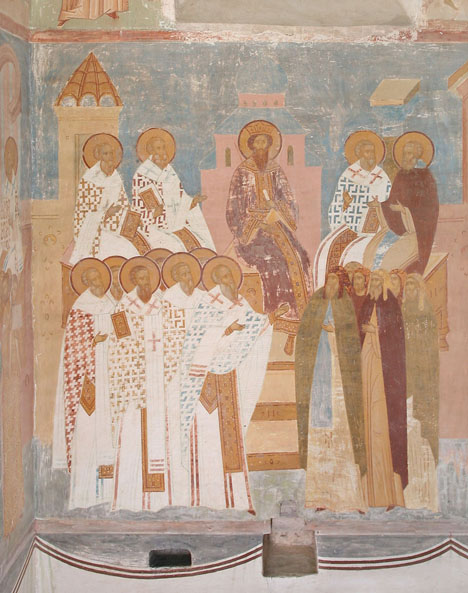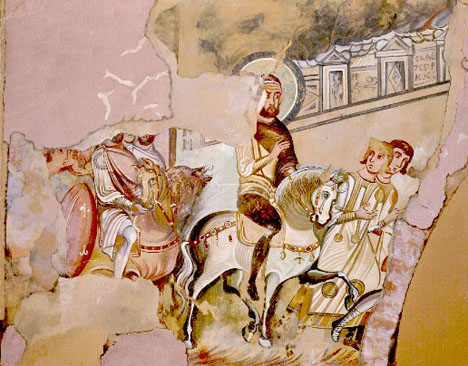
Fresco of the Holy and Ecumenical Sixth Council. Virgin Nativity Cathedral of the St. Ferapont Monastery, Belozersk, by Dionisy in1502.
Concerning the Canons of the holy Fathers and regional Councils
"The Holy and Ecumenical Sixth Council (which was the third one to be held in Constantinople) was held in the year 680 after Christ in the time of Constantine Pogonatus, a descendant of Heracleius, in the secret chamber of the divine palace (which chamber was called the Troullos, its proceedings and transactions being comprised in eighteen Acts... The Fathers who attended it numbered one hundred and seventy, according to Photios, Nicephoros, Nilus, and Anonymous, or three hundred and eighty-nine according to others." (Rudder, p. 283)

Fresco of the Holy and Ecumenical Sixth Council. Virgin Nativity Cathedral of the St. Ferapont Monastery, Belozersk, by Dionisy in1502.
"The Holy and Ecumenical Quinisext (or Quinisextine), or more properly speaking, Sixth Council was assembled in the imperial and lustrous palace called the Troullos (or, according to the Latin spelling, Trullus), in the reign of Justinian II, who was the son of Pogonatus and was surnamed Rhinotmetus (a Greek word meaning “with the nose cut off”), in the year 691 after Christ. The number of Fathers who attended it was 327 according to Balsamon and Zonaras, but 340 according to the author of the Conciliar booklet..." (Rudder, p. 287)
Note: The Troullos or Quinisext Council is viewed by the Orthodox Church as being a continuation and completion of the Sixth Ecumenical Council (or sometimes it is said of the Fifth and Sixth) that had not issued any Canons.‡ That it has not been viewed as a separate council is also witnessed to by the fact that icons or frescos of the Seven Ecumenical Councils are found, but not of the Troullos or Quinisext Council itself.

The 'adventus' (triumphal entry) of Justinian II into Thessalonike after his victory over the Bulgars of Macedonia.† Reconstruction of a 7th or early 8th century fresco from B&W photographs and water colors of the original in the basilica of Hagios Demetrios, Thessalonika (the original apparently having been lost or damaged in a fire in 1917).
This too has appeared best to the [sic] this holy Council, as well as most important, that the 85 Canons handed down to us in the name of the holy and glorious Apostles, and as a matter of fact accepted and validated by the holy and blissful Fathers preceding us, be henceforth retained and left firm and secure for the care of souls and the cure of diseases. But inasmuch as we are ordered in these Canons to accept the Injunctions of the same holy Apostles (as transmitted) through Clemens, into some of which certain spurious passages destitute of piety have been interpolated long ago by the heterodox to the detriment of the Church, and have tarnished the becoming and natural beauty of the divine dogmas for us, we have suitably weeded out such ordinances in furtherance of the edification and security of the most Christian flock, not in the least way being minded to approve the fantastic inventions of heretical mendacity that have been inserted in the genuine and uncorrupted didache (or teaching) of the Apostles. On the other hand, we ratify all the rest of the sacred Canons promulgated by our holy and blissful Fathers, to wit: the three hundred and eighteen foregathered in Nicaea, those convened in Ancyra, and furthermore also those who met in Neocaesarea, likewise those who attended the meeting in Gangra, but in addition to these also those who convened in Antioch, Syria, and furthermore also those who held a Council in Laodicea; further, again, the one hundred and fifty who convened in this God-guarded and imperial capital city, and the two hundred who assembled at an earlier time in the metropolis of Ephesus, and the six hundred and thirty holy and blissful Fathers who met in Chalcedon. Likewise those who convened in Sardica; furthermore those in Carthage. Further and in addition to all these those now again convened in this God-guarded and imperial capital city in the time of Nectarius the president of this imperial capital city, and of Theophilus who became Archbishop of Alexandria. Furthermore also of Dionysius who became Archbishop of the great city of Alexandria, and of Peter who became Archbishop of Alexandria and a Martyr withal, and of Gregory the Thaumaturgus (or Miracle-worker) who became Bishop of Neocaesarea, of Athanasius the Archbishop of Alexandria, of Basil the Archbishop of Caesarea in Cappadocia, of Gregory of Nyssa, of Gregory the Theologian, of Amphilochius the Archbishop of Iconium, Timothy a former Archbishop of the great city of Alexandria, of Theophilus an Archbishop of the great city of the Alexandrians, of Cyril an Archbishop of Alexandria, and of Gennadius who became a Patriarch of this God-guarded imperial capital city. Furthermore, the Canon promulgated by Cyprian who became an Archbishop of the country of Africa and a martyr, and by the Council supporting him, who alone held sway in the places of the aforesaid presidents, in accordance with the custom handed down to them; and no one shall be permitted to countermand or set aside the Canons previously laid down, or to recognize and accept any Canons, other than the ones herein specified, that have been composed under a false inscription by certain persons who have taken in hand to barter the truth. If, nevertheless, anyone be caught innovating with regard to any of the said Canons, or attempting to subvert it, he shall be responsible in respect of that Canon and shall receive the penance which it prescribes and be chastised by that Canon which he has offended. (Rudder, pp. 294-295)
† Historical note: Under Constans II a Bulgarian horde, forced by the Khazars to move westward from the steppes bordering the Sea of Azov, settled at the mouth of the Danube, and later moved farther south, entering into Byzantine territory. In the year 679 Constantine IV undertook a campaign against them; the expedition ended in complete defeat of the Byzantine army, and the Emperor was forced to negotiate a treaty. The mouth of the Danube and part of the Black Sea coast remained in the hands of the Bulgarians. (Vasiliev, A.A., History of the Byzantine Empire, Vol. 1, The University of Wisconson Press, 1952, p. 219). With a great military campaign in 688–689, Justinian II succeeded where his father had failed—or perhaps we should say completed what his father had started—and defeated the Bulgars of Macedonia and was finally able to enter Thessalonica as commemorated in the fresco above (Ostrogorsky, George; Hussey (trans.), Joan (1957), History of the Byzantine State, New Brunswick, N.J.: Rutgers University Press, p. 116–22). It is interesting to note that both councils followed shortly after the campaigns against the Bulgarians.
‡ "...more properly speaking this Council is or ought to be designated the sixth, because, though the later exegetes of the Canons sometimes call it the Quinisext (or Quinisextine), and others do too, by reason of the fact that it may be said to have supplied what the Fifth and Sixth Councils failed to provide—that is to say, that it furnished Canons to help in the regulation of the ecclesiastical polity, such as those Councils failed to promulgate—yet, in spite of the significance of this fact, it may be averred that, properly and truly speaking, this Council is and ought to be called the Sixth Ecumenical. Firstly, because, according to the author Romanus in his Prolegomena to the present Council, the prelates who convoked the Sixth Ecumenical Council in the reign of Pogonatus convoked also this one in the reign of his son Justinian. For, according to him, forty-three of the bishops who attended the former were present also at the latter. It would appear, however, that there were more of them, judging from the words of St. Tarasius which he addressed to the Seventh Ecumenical Council. Secondly, because the Seventh Ecumenical Council, in its Act 4 and its Act 8, and in its first Canon, specifically calls it the Sixth. Adrian II, too, in his letter to Tarasius, accepts its Canons as if considering it the Sixth Ecumenical Council proper (page 748 of the Collection of Councils), and in writing to Emperor Charles of France he calls it the Sixth and Holy Council. The legates of the Pope, too, confirmed it as the Sixth at the Seventh Ecumenical Council; and Pope Innocent III says in reference to c. XXXII of the Council, "it was arranged at the Sixth Council"; and Gratian (i.e., Franciscus Gratianus) refers to it by its proper name as the Sixth. And thirdly, also because this Council is identical with the Sixth more than with the Fifth Ecumenical Council, both as being closer to it in point of time and as having been held in the same geographical locality, since it convened in the very same palace of the Troullos (or Trullus) as that in which the Sixth Ecumenical Council convened." (Rudder, p. 288)